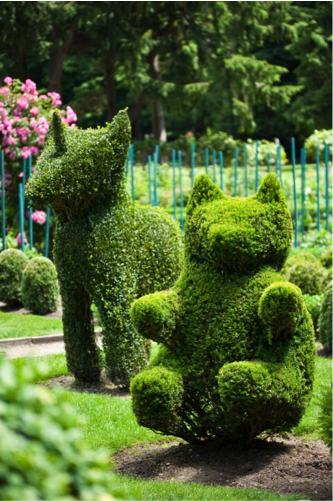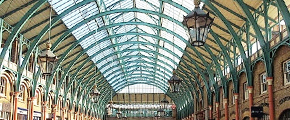The bees are buzzing, the birds are chirping, and the flowers are blooming. It’s springtime, and nowhere is this more apparent than in the colorful and lively parks and gardens of North America. To get a sense of the spirit of spring and truly appreciate the warm weather and verdant scenery, you and yours should pack a picnic and journey to any of the following glorious gardens around the continent.
1. Longwood Gardens, Philadelphia
Expanding over 1,077 acres to include 20 indoor gardens, 20 outdoor gardens, 4.5 acres of greenhouses, and one of the oldest arboretums in the country, Longwood Gardens is an astounding display of horticulture. Each of the greenhouses, in which thrive at least 5,500 different species of plants to create one of the most astounding conservatory structures in the world, boasts a distinct theme; for example, visitors can tour the Orangery for dizzyingly bright blooms or explore the Orchid House to see some of the rarest flowers on Earth. While you take in this breathtakingly beautiful flower-filled space, you should keep your ears peeled for the Longwood Organ, an instrument with 10,010 pipes that can be heard throughout the gardens. 
2. Botanical Gardens, Niagara Falls
Gardens shouldn’t be judged on size alone; at just 99 acres, Niagara Falls’s Botanical Gardens offers thousands of blooms carefully arranged into stunning decorative displays. In fact, students from the resident School of Horticulture use the sight to experiment with new, fantastic designs, so the garden is constantly morphing into gorgeous and impressive shapes. Niagara Falls has some of the most fertile soil on the continent, which allows horticulturists to educate visitors on a wide range of plant species, from towering trees to tiny herb bushes. During your stay in Niagara Falls, you can’t miss the magnificent and massive floral clock, a functioning timepiece with a face of ever-changing greenery and blooms.
3. Magnolia Plantation and Gardens, Charleston
The Magnolia Plantation has a history reaching back to 1676, when the Drayton family (who still owns and operates the site today) built a house and small garden on the property to entertain guests. Since then, the gardens have expanded to cover more than 464 acres, but they still maintain a romantic aesthetic which has largely disappeared from American horticulture. Magnolia Gardens strikes a balance between rigidly controlled formal gardens and natural landscape to create a serene, picturesque space “like Eden,” as the team explains. In fact, Magnolia includes a dedicated Biblical Garden, which contains every plant species mentioned in the Good Book. In addition, you can see the most diverse collection of camellias in the country and get lost in the hedge maze that replicates England’s famous Hampton Court. 
4. Topiary Park, Columbus
Most visitors might come to Topiary Park and see an extravagantly tended garden, but art enthusiasts undoubtedly see a landscape of a painting of a landscape. Indeed, the most astounding (and famous) area of Topiary Park is James T. Mason’s topiary interpretation of legendary post-impressionist painter George Seurat’s “A Sunday Afternoon on the Isle of La Grand Jatte.” The iconic work becomes life-size and leafy as various fragrant yew shrubs transform into noble picnickers and park-goers. Kids in particular love exploring the gardens and identifying the different shapes, so you can’t go wrong bringing them along on your horticultural adventure.
5. Lewis Ginter Botanical Gardens, Richmond
At a modest 50 acres, Lewis Ginter Botanical Gardens is a horticultural jewel in the heart of bustling Richmond, Virginia. Despite its small size, the gardens include several distinct regions and buildings, maximising variety for an exciting and fascinating landscape. With styles as disparate as medieval cloister and Far East wilderness, these botanical gardens make learning about horticulture simply mesmerising. Devoted to educating the community and visitors about plants and their importance, the park has built a vast children’s area, which includes an international village of playhouses, an ornate tree house, and several gardens with familiar and strange plants to broaden kids’ experiences with plants.
6. Desert Botanical Garden, Phoenix
Arizona is not well-known for its lush, fertile landscape, but the horticulturists at the Desert Botanical Garden dispel any notions that the Sonoran Desert is a lifeless, barren place. Sun-loving succulents like agave and cactus come in all shapes, sizes, and colours, and many of them produce colossal blooms in outstanding hues. The late winter and spring are the best times of year for you to visit the garden, as the grounds erupt with millions of brightly coloured wildflowers and the caterpillars transform into thousands of jewel-toned butterflies.

 Getting a Bamboo Tattoo in Thailand
Getting a Bamboo Tattoo in Thailand 1 Year Living in Bangkok
1 Year Living in Bangkok  Packing List Revisited 2013
Packing List Revisited 2013  Tiger Kingdom, Chiang Mai, Thailand
Tiger Kingdom, Chiang Mai, Thailand  Covent Garden, London, UK
Covent Garden, London, UK 

{ 0 comments… add one now }